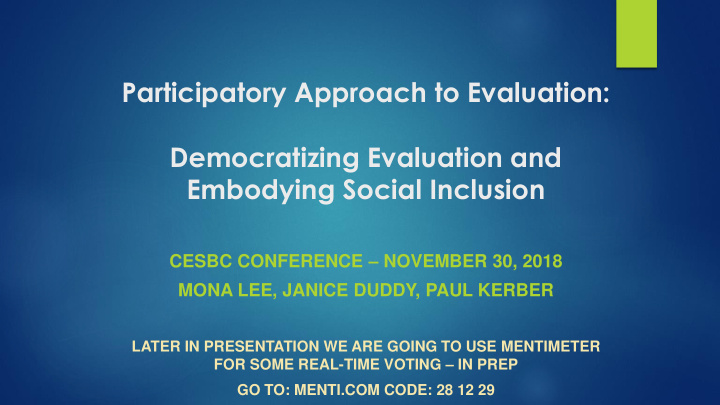



Participatory Approach to Evaluation: Democratizing Evaluation and Embodying Social Inclusion CESBC CONFERENCE – NOVEMBER 30, 2018 MONA LEE, JANICE DUDDY, PAUL KERBER LATER IN PRESENTATION WE ARE GOING TO USE MENTIMETER FOR SOME REAL-TIME VOTING – IN PREP GO TO: MENTI.COM CODE: 28 12 29
Have you ever used a participatory evaluation approach? REAL TIME VOTING Go to: menti.com CODE: 28 12 29
Pacific AIDS Network: Overview Who are we? Provincial network of 40+ member organizations who work across BC to respond to HIV, hepatitis C and related conditions
Community-Based Research and Evaluation Department Some similarities between community- based research (CBR) and evaluation Mutual learning and adaptation between approaches within our department
Greater Involvement of People Living with HIV/AIDS (GIPA) & Meaningful Engagement of People Living with HIV/AIDS (MEPA) Principle that all HIV programs and services strive towards UNAIDS Policy Brief
What is Participatory Evaluation? “Participatory evaluation … isn't simply a matter of asking stakeholders to take part. Involving everyone affected changes the whole nature of a project from something done for a group of people or a community to a partnership between the beneficiaries and the project implementers. Rather than powerless people who are acted on, beneficiaries become the copilots of a project, making sure that their real needs and those of the community are recognized and addressed. Professional evaluators, project staff, project beneficiaries or participants, and other community members all become colleagues in an effort to improve the community's quality of life.” ( Community Toolbox: Participatory Evaluation)
PAN’s Definition and Implementation of Participatory Evaluation Collaborative, change-oriented and inclusive Built in supports Capacity bridging Built on mutual respect and trust Long-term and sustainable relationships Flexible Builds on community strengths Methodological rigor and sound ethical practices
Some benefits of using this approach includes: Community- and team- building Shared ownership of process and results Enhanced utilization of evaluation findings Democratize evaluation Social Inclusion
Positive Leadership Development Institute (PLDI) PLDI is a leadership training program for people living with HIV (PLHIV) GIPA/MEPA (Greater involvement of People Living with HIV / Meaningful Engagement of PLHIV) are at the centre of PLDI, PAN and the greater HIV sector
PLDI Participatory Impact Evaluation Funder-mandated evaluation of Peer-led participatory A capacity-building program for evaluation! people with lived experience in An organization that values and embodies highly participatory approach
We have accomplished this by: Evaluation Steering Committee Hiring, training and working with Peer Evaluators Ensuring Peer Evaluators take on leadership roles Fairly compensating Peer Evaluators Building in ongoing support system for Peer Evaluators from the PAN staff
Peer Evaluator Accomplishments…
What do evaluation nerds do? Evaluate the evaluation! Using a meta-evaluation to: Reflect on engaging in a Participatory Evaluation approach …
Findings from Meta-Evaluation: > BENEFITS COSTS (of engaging in participatory evaluation) • Value of lived experience • Added time and resources • Improved recruitment • Human resources • Critical thinking • Training Peer Evaluators • Building relationship & trust • Compensation for Peer Evaluators • Capacity and skills building for all and Steering Committee members • Empowerment • Working with a geographically-spread • Shared ownership out team
Survey respondents’ level of agreement with statements assessing the benefits of adopting a participatory evaluation involving Peer Evaluators (n = 11 to 12)
What questions do you have at this point? REAL TIME VOTING Go to: menti.com CODE: 28 12 29
Small Group Exercise: Building a Participatory Evaluation Checklist Get into groups three Use the checklist worksheet to discuss (10 mins): What do you need to be successful using a participatory evaluation approach? (See sub categories) When would using a participatory approach to evaluation be harmful or detrimental? Why?
PAN’s Participatory Evaluation Checklist We will have copies for you or you can find it on our website: https://pacificaidsnetwork.org/2018/11/27/pan- presents-at-the-2018-cesbc-conference-on- participatory-approaches-to-evaluation/
Questions??
Acknowledgements PAN wishes to thank the Public Health Agency of Canada (the views expressed herein do not necessarily represent the views of the Public Health Agency of Canada) and REACH 2.0 for the financial support to conduct this impact evaluation. The impact evaluation presented here was designed by a Steering Committee comprised of people living with HIV (PLHIV), key stakeholders, PAN staff and contractors, as well as a team of four Peer Evaluators hired to conduct this project. A big thank you to this team and to all the participants who contributed their time to this evaluation! If you have questions or want to learn more please contact: Janice Duddy – janice@pacificaidsnetwork.org
Recommend
More recommend